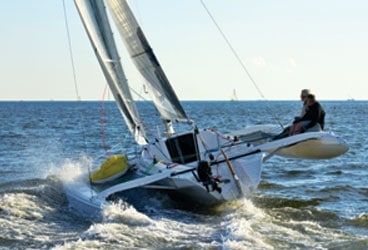
BOTYsprint750St
When Corsair Marine introduced the F-27 folding trimaran in 1985, it quickly became the dominant builder of practical, trailerable, cruiser/racer trimarans in the United States. Several hundred were sold, encouraging the company to introduce the F-24 Mark 1, a smaller version, in 1992. The sailing performance of the F-24 was considerably less than the F-27, which disappointed the racing crowd. Corsair responded by updating the F-24 with a rotating mast, daggerboard, reduced accommodations, and a lighter weight, but it was still no barnburner. So, when we sailed the new Sprint 750, which is essentially an upgrade of the F-24, I was unprepared for its stunning performance.
The 750 is a daysailer with a small cabin that incorporates a portable potty, small dinette, and V-berth capable of sleeping two. Aft of the cabin is a long, spacious cockpit, capable of seating six adults. The cockpit layout has two winches forward and the traveler well aft, allowing easy sailhandling without interfering with passengers. Corsair is pushing the Sprint as a performance sportboat with a racing agenda and a strong one-design class structure, but handicap competition should also be an attractive potential for future Sprint owners.
During our BOTY test sail of the Sprint we sailed in a variety of conditions and it was a delight when the Sprint proved responsive and fast in the light stuff. It tacks like a dinghy and accelerates, which is is uncommon among most multihulls, even beach cats, and should give the racing sailor the ability to tack on minor shifts that otherwise might be ignored.
The real fun with the Sprint came sailing downwind with the breeze getting up to the 14-knot range. A large chute, in combination with a working jib and square-top main provided speeds in the 15- to 17-knot range on a broad reach, while maintaining downwind jibe angles of 90 degrees or less. This is where the serious reduction in weight, compared to its ancestor, allows the Sprint to really shine, actually getting up on a plane when reaching and running in any reasonable breeze. The main hull has a wide transom and flat run aft, and was originally designed to plane, but at only 24 feet, crew weight placement is crucial.
We tested the 750 with two and four crew, and found two was perfect. Extra bodies noticeably reduced performance and planing ability. Fortunately, the boat is set up so a competent crew of two can competitively race it. In winds over 10 knots, a third crew would be beneficial for adding ballast and the extra hands. The boat was excellent in many ways, and only needed minor rigging and sail handling adjustments that could easily be changed. For example, the spinnaker halyard was hard to reach and release on the mast, and a poor tack-line lead made the spinnaker difficult to take down. Leads for both the jib and screacher need to be made adjustable for various conditions and points of sail.
Construction is the same as on all Corsair boats. Vinylester resin is used to bond two fiberglass skins over a foam core under vacuum-bag pressure. This construction technique has been refined over the years, producing strong, reasonably lightweight boats at an affordable price. Of most importance, they hold up well; many boats are still sailing after almost 20 years of ocassionally phenomenal abuse.
At $49,350, with trailer and 5-horsepower Nissan 4-stroke engine, the Sprint is a great boat for the money and certainly the most fun to sail. With the boat we tested, the only extras were the screacher and spinnaker, which depending on the sailmaker would cost $3,000 to $5,000.









